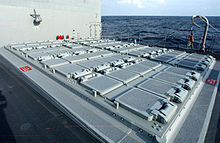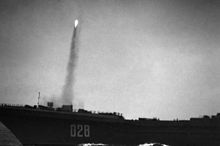- Vertical launching system
-
For the Brazilian Space Agency launcher, see VLS-1.
 The VLS cells on board USS San Jacinto.
The VLS cells on board USS San Jacinto.
A vertical launching system (VLS) is a system for holding and firing missiles on surface ships and submarines used by many navies around the world. Each VLS system consists of a number of cells, which can hold one or more missiles ready for firing. Typically, each cell can hold a number of different types of missiles, allowing the ship flexibility to load the best set for any given mission. Further, when new missiles are developed, they are typically fitted to the existing VLS systems of that nation, allowing existing ships to use new types of missiles without expensive rework. When the command is given, the missile flies straight up long enough to clear the cell and the ship, and then turns on course.
A VLS allows surface combatants to have a greater number of weapons ready for firing at any given time compared to older launching systems such as the Mk-13 single-arm and Mk-26 twin-arm launchers, which were fed from behind by a magazine below the main deck. In addition to greater firepower, VLS is much more damage tolerant and reliable than the previous systems, and has a lower radar cross-section (RCS). The U.S. Navy now relies exclusively on VLS for its guided missile destroyers and cruisers.
The most popular VLS system in the world is the Mk 41, developed by the US Navy. More than 11,000 MK 41 VLS missile cells have been delivered, or are on order, for use on 186 ships and 19 ship classes, in 11 navies around the world. This system currently serves with the US Navy as well as the Australian, Canadian, Dutch, German, Japanese, New Zealand, Norwegian, South Korean, Spanish, and Turkish navies[1].
The advanced Mk 57 VLS system is projected to be used on the new Zumwalt class destroyer. The older Mk-13 and Mk-26 systems remain in service on ships that were sold to other countries such as Taiwan, Greece, and Poland.
When installed on a SSN (nuclear-powered attack submarine), a VLS allows a greater number and variety of weapons to be deployed in comparison to using only torpedo tubes.
Contents
Hot launch and cold launch
A VLS system can be either hot launch, where the missile ignites in the cell, or cold launch, where the missile is ejected and then the missile ignites. A hot launch system does not require an ejection mechanism, but does require some way of disposing of the missiles exhaust and heat as it leaves the cell. If the missile ignites in a cell without an ejection mechanism, the cell must withstand the tremendous heat generated without igniting the missiles in the adjacent cells.
An advantage of a hot-launch system is that the missile propels itself out of the launching cell using its own engine, which eliminates the need for a separate system to eject the missile from the launching tube. This potentially makes a hot-launch system relatively light, small, and economical to develop and produce, particularly when designed around smaller missiles. A potential disadvantage is that a malfunctioning missile could destroy the launch tube.
The advantage of the cold-launch system is in its safety: should a missile engine malfunction during launch, the cold-launch system can eject the missile thereby reducing or eliminating the threat. For this reason, Russian VLSs are often designed with a slant so that a malfunctioning missile will land in the water instead of on the ship's deck. As missile size grows, the benefits of ejection launching increase. Above a certain size, a missile booster cannot be safely ignited within the confines of a ship's hull.
American VLSs have the missile cells arranged in a grid with one lid per cell and are "hot launch" systems; the engine ignites within the cell during the launch, and thus it requires exhaust piping for the missile flames and gasses. France, Italy and Britain use a similar hot-launching Sylver system in PAAMS. Russia produces both grid systems and a revolver design with more than one missile per lid. Russia also uses a cold launch system for some of its VLS missile systems, e.g., the Tor missile system. The People's Republic of China uses a circular "cold launch" system that ejects the missile from the launch tube before igniting the engine.
Systems by nations
- Adelaide class frigate - Mk 41 (8 cells)
- Anzac class frigate - Mk 41 (8 cells)
- Iroquois class destroyer - Mk 41 (29 cells)
- Charles de Gaulle (R91) aircraft carrier - SYLVER (32 cells)
- Horizon class frigate - SYLVER (48 cells)
- Van Speijk class frigate - SS-26 Yakhont VLS (4 cells)
- Cavour (550) aircraft carrier - SYLVER (32 cells)
- Horizon class frigate - SYLVER (48 cells)
- Atago class destroyer - Mk 41 (96 cells)
- Kongō class destroyer - Mk 41 (90 cells)
- De Zeven Provinciën class frigate - Mk 41 (40 cells)
- Fridtjof Nansen class frigate - Mk 41 (32 cells)
- Formidable class frigate - SYLVER (32 cells)
- Chungmugong Yi Sun-shin class destroyer - Mk 41 (32 cells) + K-VLS (32 cells)
- King Sejong the Great class destroyer - Mk 41 (80 cells) + K-VLS (48 cells)
- Álvaro de Bazán class frigate - Mk 41 (48 cells)
- Type 45 destroyer - SYLVER (48 cells)
 A Tomahawk missile canister being loaded into a VLS aboard the Arleigh Burke class destroyer USS Curtis Wilbur
A Tomahawk missile canister being loaded into a VLS aboard the Arleigh Burke class destroyer USS Curtis Wilbur
- G class frigate- 8 cell VLS
- Barbaros class frigate- VLS Mk 41 Mod.8 [2]
- Arleigh Burke class destroyer - Mk 41 (96 cells)
- Ticonderoga class cruiser - Mk 41 (122 cells)
See also
- List of United States Navy Guided Missile Launching System
References
External links
Categories:- Naval weapons
Wikimedia Foundation. 2010.


